Fact: Just about anyone can learn to ski, no matter how they are abled. How do we know this? We’ve learned it from Vermont’s adaptive skiing programs, which are offered at a number of Vermont’s resorts up and down the state. Don’t take our word for it. Let’s hear from some of the families who have experienced these programs first-hand.
Meet Delaney
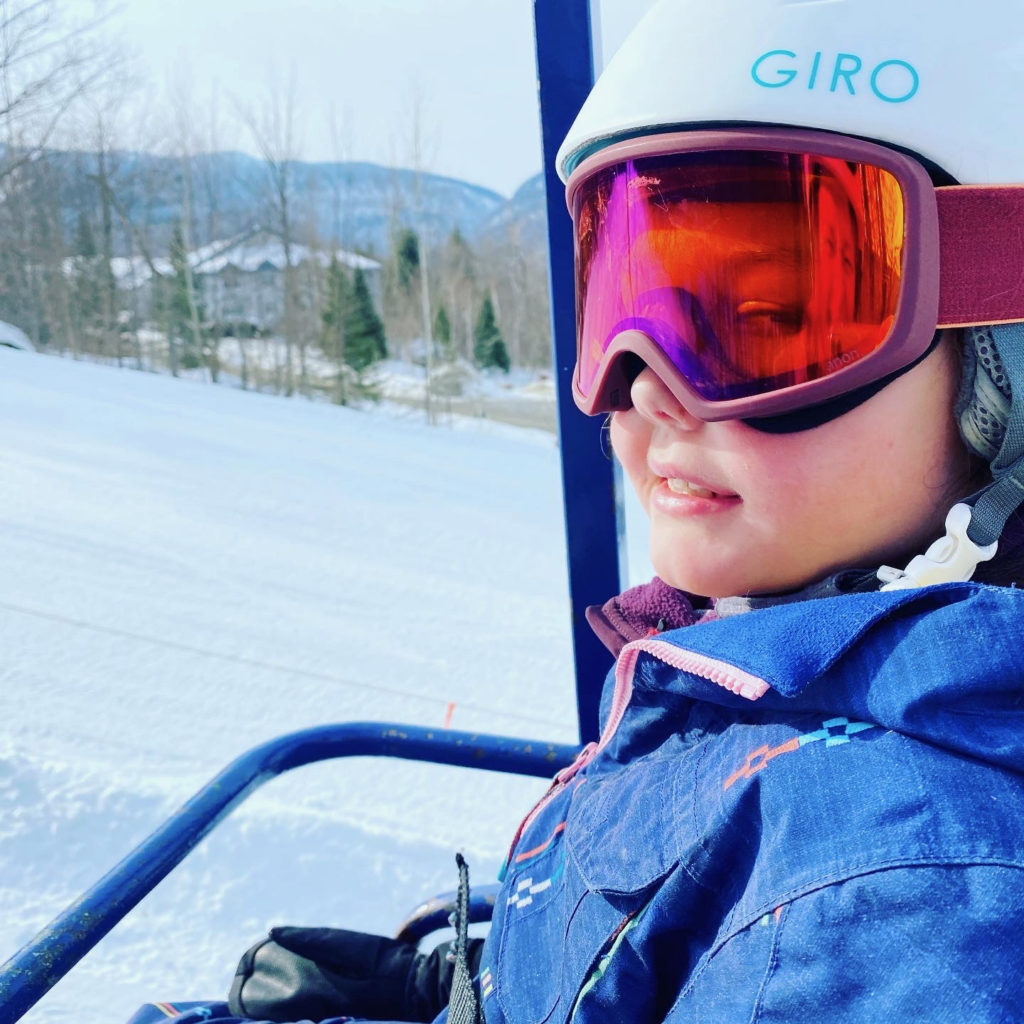
Delaney (aka Del) is only 12 years old but she already has 7 years of skiing at Smuggler’s Notch under her belt. Del has a rare neurological disorder called Alternating Hemiplegia of Childhood (AHC) that affects her motor function, behavior, speech and temperature regulation. She also has epilepsy and autism.
Most of all what Del has is a sense of independence. She loves to be out of the house and doing something active. And like any pre-teen, she’d rather not have mom and dad along. The Smuggler’s Notch Adaptive Program (SNAP) offers her the chance to experience all of these things.
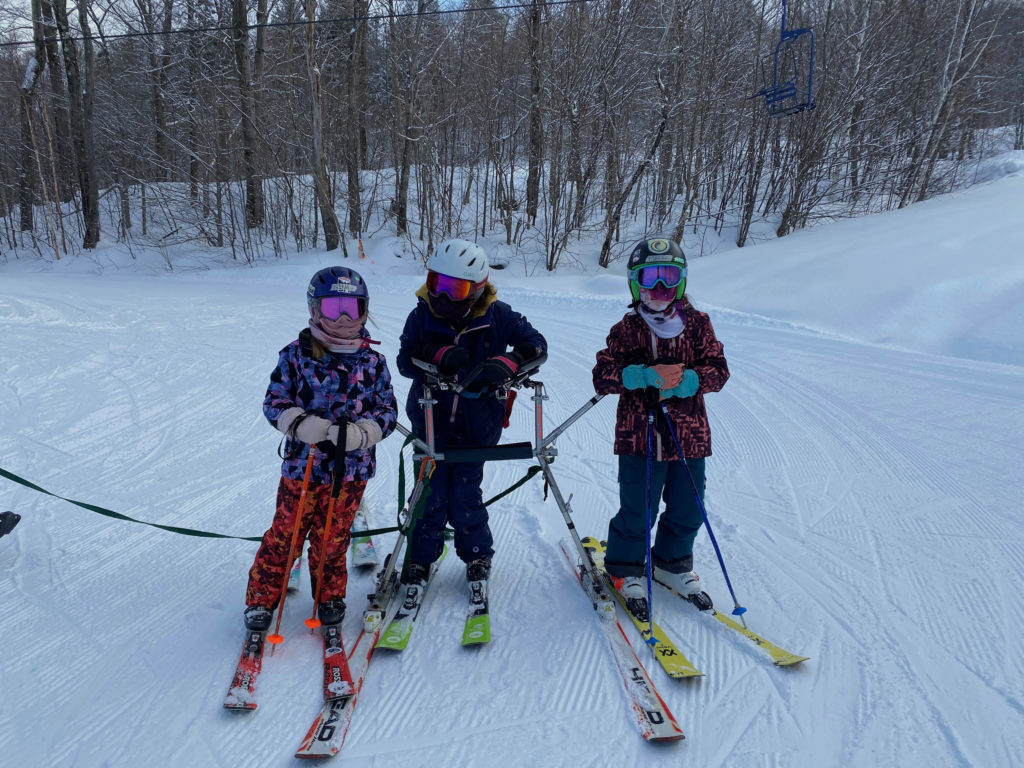
Katrina, Delaney’s mom, said that Del started skiing because she and her husband Ben were looking for a way for their family to stay active. “Both my husband and I, we need to be outside and we need to active as human beings. We also wanted to do the Smuggs ski school for our other daughters (Mara, now 9 and Nina who is 6),” she said. “Smuggs just took Del in with open arms. It wasn’t a question of if they could do it or she could do it. The answer was always absolutely yes.”
SNAP provides both the equipment and the trained instructors and volunteers that kids like Del need to get them up and down the mountain. She uses a mobility belt with a carabiner to ride the chairlift and skis alternately using a slider or a bi-ski. The slider is a mounted frame that looks like a walker, attaches to separate skis and is tethered and steered by a trained instructor. The bi-ski is a bucket seat with two skis underneath it.
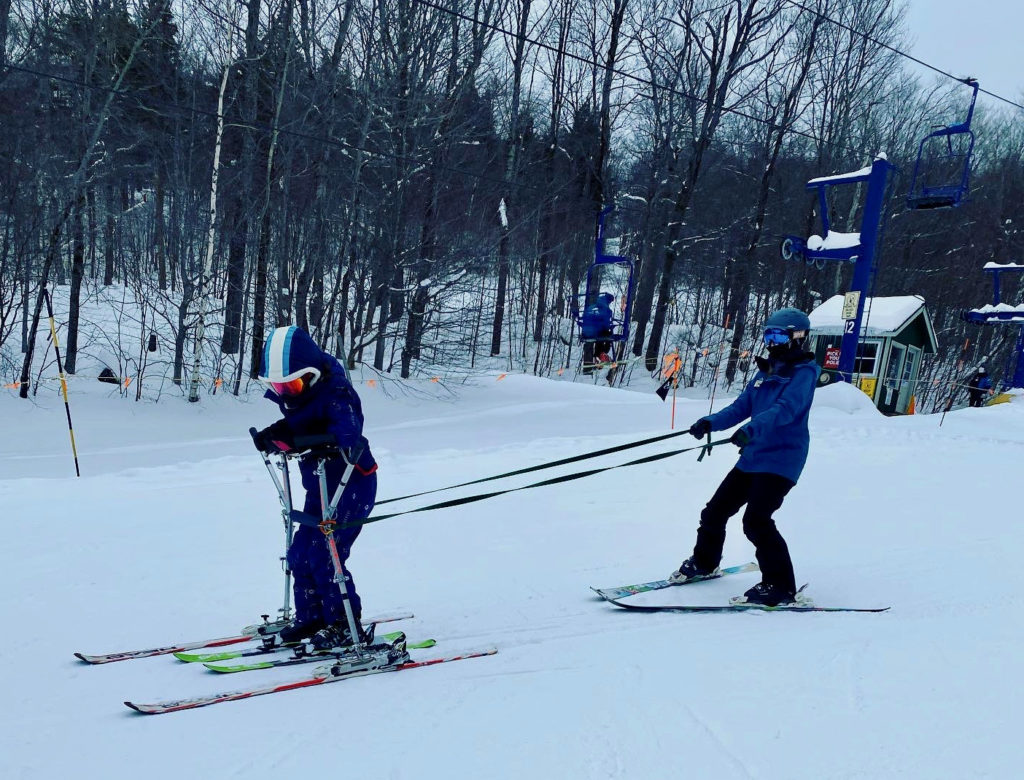
“I’ve never doubted that the staff at Smuggs can manage and help,” Katrina said. And that’s been critical “If Del trusts you, things will go well. Knowing that the people will stick with her is important. She can sense that. If something is going to be tricky physically she knows her limitations, but this keeps her from accepting them all of the time.”
Meet Jack

Jack is 18 and has been skiing for 11 years. Like all of us he is still learning every time he hits the mountain at Bromley Resort. He has autism and motor planning issues that make it challenging for him to do activities requiring physical coordination. A recent focus has been on bending his knees using the same “hut, hut” cues as a football quarterback.

When Jack started skiing at 7, his brothers were 4 and 5, so his parents put them all in lessons at Bromley at the same time. Jack was in the adaptive skiing Bart program and his brothers in the Bromley lesson program. But it wasn’t easy for Johanna, Jack’s mom, to decide whether to start him in lessons at the Bart Adaptive Sports Center.
“With Jack I’m always so hesitant with who I leave him with,” she said. “It takes so much prep time, it’s not always worth it, so that was the hardest piece as a parent was to leave him with the teachers on the first day.”
Happily, Johanna’s worries immediately turned into confidence in the instructors, the volunteers, and Jack. He started out using a tether and a ski wedge but can now ski independently. Johanna said, however, that he prefers to ski with the Bart instructors. Just this year started holding his own poles on the ski lift.
She said that the key to Jack’s success is the way he’s been taught at Bart. “They offer a lot of prompts and breaking things down and focusing on certain pieces,” she said. “There’s lots of repetition and isolating the things to work and then helping him put them together once he’s mastered each piece.”
One of the best aspects of the Bart program has been that sharing skiing was a rare experience for the family. “It never happens that all three kids can do the same thing at the same time,” Johanna said. “There’s not very many things we can do together as a family. And for my husband Mark and I, we can have some respite time, just us two on the chairlift.”
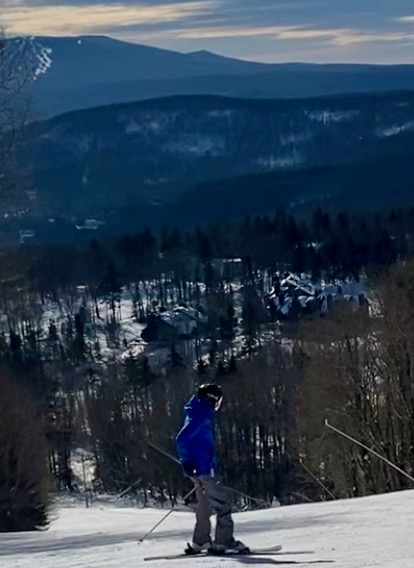
Although Jack has tried adaptive programs at other resorts, Johanna said that their experience at Bromley has been so positive that it will forever be her family’s home mountain. In fact, the Bart program at Bromley has been so important for Jack and his entire family that his younger brother Ryan who is 15 recently started volunteering for the program as a way to give back.
“We will never leave Bromley.” Johanna said. “They make it fun and they are so encouraging. Literally Bart is our second family.”
Meet Cate

It’s important to keep your eyes open when Cate is around at Pico Mountain because she’s probably going to be moving pretty fast and you might miss her. But even if you don’t see her, you may hear her from the chairlift because the 12-year-old, who has nonverbal autism and low muscle tone, likes to let out a “yippee” sound when she is skiing.
Cate has been skiing at Pico since she was 3 and her mom Lisa said that she likes speed. But she stays in control and skis independently now that she no longer needs the tether that she used when she was younger. Like Katrina and Johanna, she credits the teachers and volunteers, in this case in the Vermont Adapative Ski & Sports program.
“The volunteers are magical to us. We’ve never had a bad experience,” Lisa said. “Right now they are working on technique a lot. Cate can get lazy, so they are working on making her turns. She will ski with a lead instructor out front calling ‘follow me, follow me’ and volunteers on the side and behind to keep other skiers off. Cate even goes down black diamonds. She snowplows her turns, but she can get down everything.”
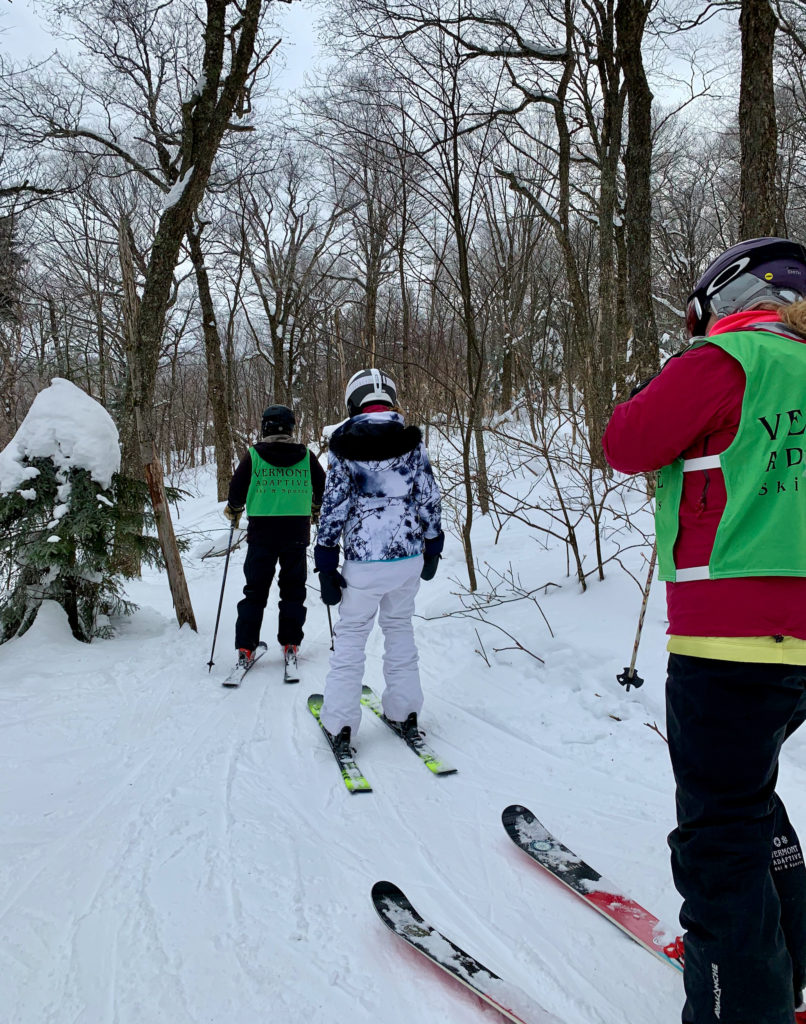
Lisa is a proponent of letting Cate have freedom to try some more challenging terrain and loves that the Vermont Adaptive instructors are willing to let her stretch herself.
“One of the guys said let’s take her to the top and they took a picture of her at the Pico Peak sign and texted it to her dad Tom who gets much more nervous than I do,” she said, laughing.
Lisa is also frank about the challenges of helping Cate ski. Getting all the gear together, making sure she has used the bathroom and will be warm enough can all be challenging. “But the sheer joy on her face when she’s skiing is addictive,” Lisa said. Ultimately, the independence and pleasure that Cate get from skiing make it worthwhile.
“Your kid might be uncomfortable, they might fall down, but they are in safe, loving hands,” Lisa said. “Just like the rest of us they grow when they face adversity. It’s good for them to know that their parents aren’t always going to be there and that they will be OK.”
Adaptive skiing program tips for parents
The number one tip that all three parents offered for parents considering adaptive skiing programs was to assume that your child can learn to ski and to trust the volunteers and instructors. Parents of all of these intrepid skiers all said that the most remarkable thing about the adaptive skiing programs is the ability of the staff to problem solve and address the needs of any child, including those in wheelchairs or who are blind. They do this by working independently with your child and each other but also by partnering with the families.
“Instructors are going to interview you and get your input,” Lisa said. “They write notes after every session and review them prior to the next session. Everything is well documented. Trust the process. Trust the instructors. Steer clear when they tell you to.”
Be prepared is also a common motto.
Think about your child’s individual needs, whether that be extra hand and foot warmers, pull-ups or snacks or treats for motivation. Some children in the program bring special toys like a small stuffed animal or blanket that the instructors can use to encourage turns or offer comfort when things get a little rough. And be prepared for good and bad days.
“Be patient,” Johanna said. “and don’t throw your child into a full-day lesson right away. It’s not going to be easy every time. But the reward is so worth it for the families.”
And although each of these families have children with different needs, they share one key thing in common: Adaptive skiing has been hugely positive for their children and their families, and not just because of the joy in being outdoors or the benefits of exercise. It’s the people running the programs and the independence and encouragement they offer.
“The relationships are as important as the exercise,” Katrina said. “Del knows she has a place in the world where she is completely accepted and it’s not a question – she knows that. She can sense that.”
Learn More
To learn more about adaptive skiing in Vermont, please visit the Vermont Adaptive Ski & Sports, the Smuggler’s Notch Adaptive Program (SNAP) or the Bart Adaptive Sports Center. To see pictures and videos of Del skiing, visit DelsRide.org.
Please note that in 2021 all of the programs are operating under Vermont Covid-19 protocols that impact how the lessons are run and whether participants can go indoors and require more family involvement than normal.
Mara Gorman may live at sea level now, but she’s a native New Englander and mountain aficionado who grew up skiing in Vermont. She spends as many days each winter as she can chasing her two teen boys through glades and across mogul fields and regularly journeys far and wide to get on the slopes. Mara blogs about her family’s many travel adventures at The Mother of all Trips. She is also the author of The Family Traveler’s Handbook and an award-winning freelance writer whose work has appeared in various USA Today print publications as well as on websites such as BBC Travel. When there’s no snow, Mara and her family can be found hiking, biking and eating around the United States and Europe.
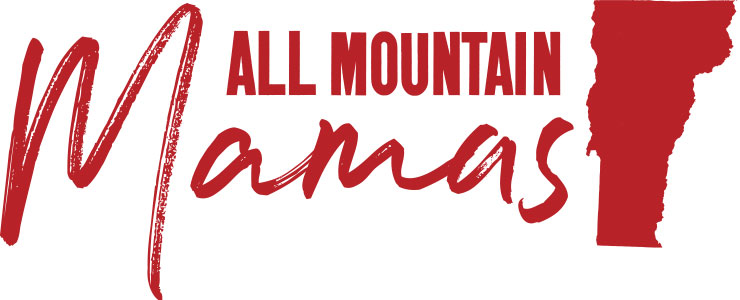
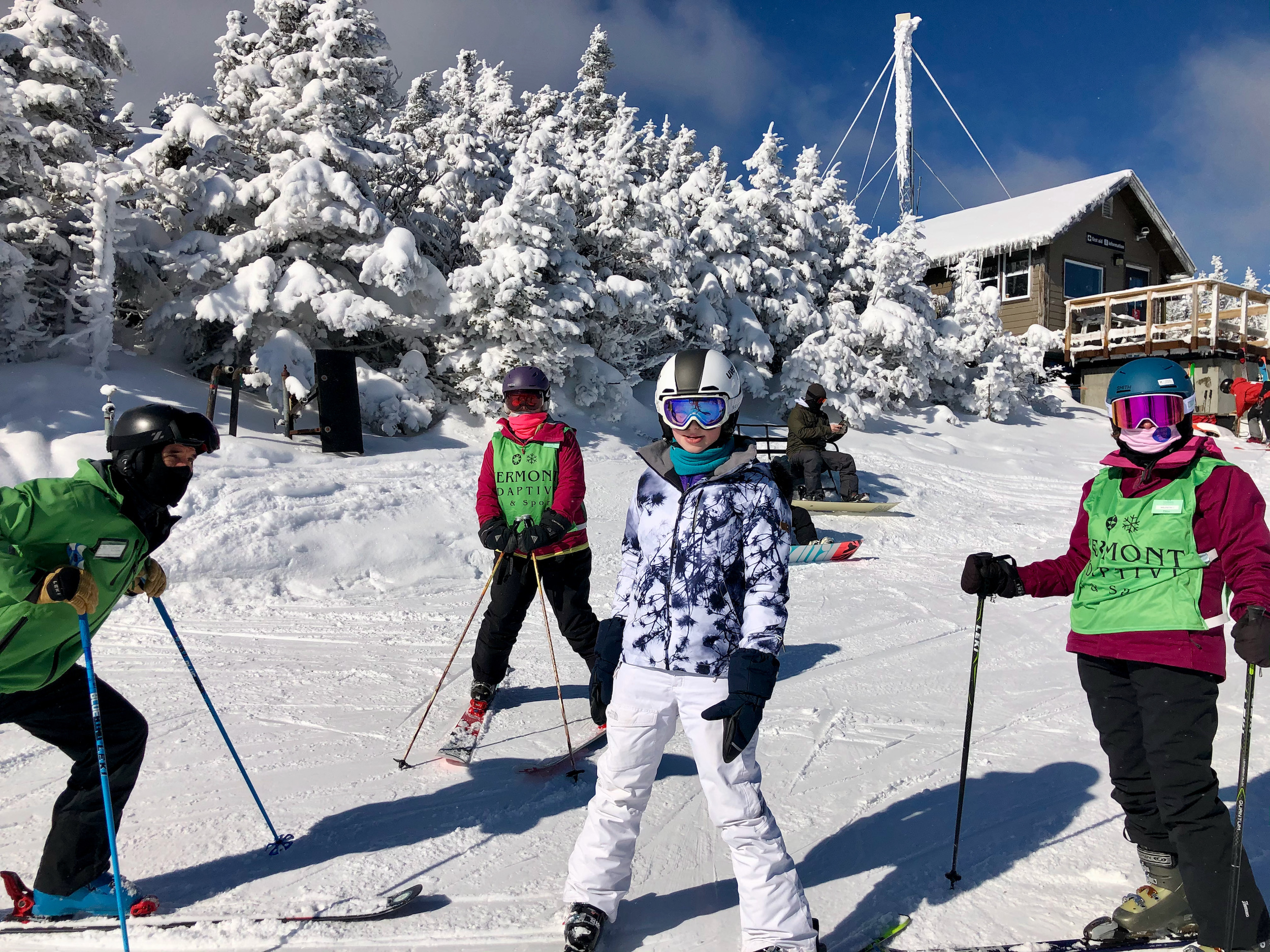
Thank you for taking the time to write about some of the wonderful adaptive programs we have in Vermont! Your article emphasizes how important outdoor recreation is to all people and the impact it has on self esteem, belonging, and creating independent skills for participants. While our organizations might technically be separate entities, the adaptive sports world works together to create opportunities for all.
Thank you for sharing such great success stories of adaptive sports. We are lucky to have Vermont Adaptive on our mountains and beyond!